Pediatric Dentistry In Bangkok, Thailand
DENTAL FOR KIDS
Tooth Decay
Tooth decay is the major cause of tooth loss in children. Tooth decay, or dental caries, is caused by bacteria. For a tooth to decay, three elements are needed: plaque, food containing sugars and starches, and a susceptible tooth.
When foods containing sugars and starches are eaten, the bacteria in plaque holds these acids onto the teeth, where they attack the enamel for twenty minutes or more. After repeated attacks, the enamel may break down, forming a cavity.
Periodontal Diseases
An early sign of periodontal disease is swollen gums that bleed easily, especially diseases are caused by the bacteria in plaque. If plaque is not removed by daily brushing and flossing–along with regular professional cleaning by a dentist –toxins created by these bacteria can irritate the gums, making them tender and likely to bleed. If not treated at an early stage, bleeding gums can lead to tooth loss.
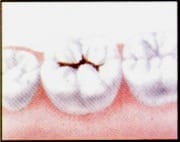
Chewing surface decay
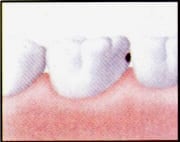
Decay between these teeth
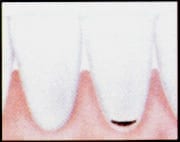
Decay along this gum line
Regular Dental Visits
Your dentist and the other members of the dental health care team play important roles in helping your child maintain good oral health. Regular dental visits will ensure that any dental problems are diagnosed and treated early, when damage is less and restorations are smaller. Take your child to see a dentist by the first birthday, and return for follow-up visits as often as recommended.
You can make an appointment for your child with your own dentist or with a pediatric dentist. Pediatric dentists have special training in dental care for children. A number of parents choose a pediatric dentist to provide their child’s dental care on the same basis that they select a pediatrician to provide their child’s medical care. Many Children who are apprehensive, or who have medical or emotional problems, can benefit from the pediatric dentist’s special training.
The dentist will assess the growth of the child’s teeth and jaws, and monitor the eruption and shedding of teeth. When necessary, X-rays will be taken to see how the teeth and facial bones are developing and to find any hidden decay. Your dentist may also advise you on ways to prevent malocclusion and provide you and your child with information on proper home dental care.
Sealants
Sealants are used to protect the chewing surfaces of the child’s back teeth. These surfaces often decay because they contain pits and fissures—tiny grooves and depressions—where plaque accumulates.
Sealants are clear or shaded plastic materials that can be painted onto these decay-prone surfaces of the teeth. By forming a thin covering over the pits and fissures, the sealants keep plaque and food out of the crevices in the teeth, reducing the risk of decay.
Sealants should be applied as the permanent teeth erupt. Ask your dentist if your child can benefit from sealants
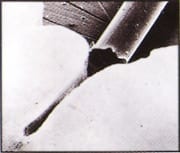
A single toothbrush bristle is too large to reach inside the fissure.
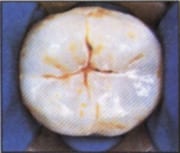
Chewing surface before sealant
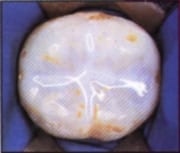
Tooth protected by shaded sealant
Baby bottle Tooth Decay
As soon as teeth appear in the mouth, decay can occur. One serious form of decay among young children is baby bottle tooth decay. This condition can occur when an infant is allowed to nurse continuously from a bottle of milk, formula, sugar water or fruit juice during naps or a night. If these liquids pool around the child’s teeth during sleep, the teeth will be attacked by acids for long periods of time, and serious decay can result. When putting your young child to bed, use only water in the bottle, or give the baby a pacifier.
Thumbsucking
Sucking is one of a baby’s natural reflexes, much like grasping for objects. It is a normal infant habit, which makes the child feel secure and happy.
Thumbsucking usually decreases after the age of two. In some cases, if a child continues vigorous and prolonged thumbsucking past the age of four, if can create problems with normal dental development. Ask your dentist whether your child’s oral habits may cause future dental problems.
Teething
When teeth begin erupting, some children may have sore or tender gums. Teething, which may start around six months and continue until age three, can make them irritable. Gently rubbing your baby’s gums with a clean finger, a small, cool spoon or a wet gauze pad can be soothing, You can also give the baby a clean teething ring to chew on. If the baby is still cranky and uncomfortable, consult your dentist or physician.
Contrary to common belief, fever is not normal for a teething baby. If your infant has a fever while teething, call your physician.
First Dental Visit: One to five years
Take your child to see the dentist by the first birthday.Your child’s first visit to the dentist can be a pleasant adventure. Talk about the visit in a positive matter-of-fact way, as you would any important new experience. Explain that the dentist is a friendly doctor who will help the child stay healthy.
During the first visit, the child’s mouth will be examined for tooth decay and other problems. The teeth may be cleaned by the dentist. The dentist will explain how the child’s teeth should be cleaned at home, how diet and eating habits affect dental health, and methods to ensure that your child gets sufficient fluoride.
Most children have a full set of 20 primary teeth by the time they are three years old. Primary teeth are just as important as permanent teeth — for chewing, speaking, and appearance. In addition, the primary teeth hold the space in the jaws for the permanent teeth.
You should start brushing the child’s teeth as soon as the first tooth erupts. Flossing should begin when all the primary teeth have erupted, usually by age 2 to 2.5. By age 4 or 5, the child may be able to brush under your watchful eye.
The preschool years are important time to help your child establish good eating habits, since you can control you child’s diet successfully. At this age, many children need to eat snacks or “mini-meals.” They cannot always eat enough food at meantime to get all the nutrients and energy they need. Help your child choose sensible snack–foods that don’t promote tooth decay.
Six to twelve years
As your child nears age 6, the jaws grow, making room for the permanent teeth. At the same time the roots of the primary teeth begin to be absorbed by the tissues around them, and the permanent teeth under them prepare to erupt.
The first permanent molars usually erupt between ages five and six, so they are sometimes called the six-year molars. Because the six-year molars do not replace any primary teeth, they are often mistaken for primary teeth. You should remember that they are permanent teeth and must be cared for properly if they are to last throughout your child’s lifetime. These molars are especially important because they help determine the shape of the lower part of the face They also affect the position and health of the other permanent teeth.
Sometimes a primary tooth is lost before the permanent tooth beneath it is ready to erupt. If primary teeth are lost too early, nearby teeth can tip or move into the vacant space when the permanent teeth are ready to come into the mouth, there will not be enough room. As a result, they may erupt out of their proper positions, leading to malocclusion. To avoid such future problems, your dentist may recommend using a space maintainer to reserve space for the permanent teeth.
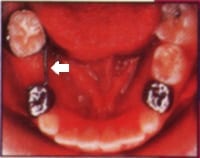
A space maintainer reserves space for the eruption of a permanent tooth.
Your dentist may recommend that your child use an over-the-counter fluoride mouth-rinse daily, after age six. Be sure to instruct and, if necessary, supervise your child in the use of these mouth rinses. By age 7, Your child should be able to brush alone. Flossing however, is a more difficult skill to master . At about age 8, the child should be able to floss his or her own teeth under your supervision.
Your child’s future eating habits are often set during this period. You should explain to your child how foods affect the teeth. Let the child know that clean teeth are less likely to decay and that brushing the teeth after eating can help prevent dental disease.
Your child should continue to visit the dentist regularly. this allows your dentist to identify and treat dental problems at an early stage, before serious damage occurs. During these visits, your dentist will do what is necessary to protect your child form dental disease. Sealants and topical fluoride gels or solutions may be applied to the teeth if needed. The child’s teeth will be professionally cleaned to remove calculus and stains.
regular dental visits are especially important during puberty when the body’s hormone levels rise. This can exaggerate the way the gums react to the toxins in plaque, increasing the chance for inflammation.
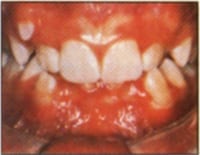
Overbite, receding lower jaw
Malocclusion
Malocclusion is a condition in which the teeth are crowded, crooked, and out of alignment with each other, Malocclusions can occur at any age, but they become particularly noticeable between the ages of 6 and 12, when the permanent teeth are coming in.
In some cases, malocclusions are inherited — for example, the jaw may be too small for the teeth. In others, the malocclusion results from factors in the child’s life, such as thumbsucking, dental injuries, or the early loss of primary teeth.
Whatever the cause, teeth that are crowded or out of position may be more difficult to clean. As a result, they are more likely to decay, and the gums more likely to become inflamed. This can affect the child’s appearance.

Corrected overbite
General dentists and pediatric dentists try to prevent malocclusions. When necessary they may refer your child to an orthodontist, a dentist who specializes in the treatments of such problems. Some preventive orthodontic treatment starts as early as age 3 or 4. During the growth period, conditions such as tooth crowding may be corrected with an orthodontic appliance.
Mouth protectors and Oral Injuries
Injuries to the teeth occur easily, especially during childhood. But many injuries can be avoided by using mouth protector. Mouth protector guard against injuries to the entire mouth area, especially the teeth, lips, cheeks and tongue. These resilient shields can also protect against other injuries by cushioning blows that might otherwise cause concussions or lead to jaw fractures.
Have your child wear a mouth protector, especially if he of she is participating in any activity which may involve falls, head contact, tooth clenching or flying equipment — anything from basketball to skateboarding, gymnastics to soccer.
There are three types of mouth protectors: ready-made, mouth-formed and custom-made. Ask your dentist for advice on the selection and use of mouth guards.
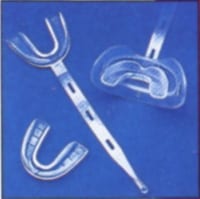
Many injuries can be avoided by using mouth protectors.
If, despite precautions, your child sustains a facial or jaw injury, see your dentist immediately. If your child’s tooth is knocked out, rinse it in cool water. Do not scrub it! If possible, put the tooth back into its socket and hold it in place for five minutes. If this cannot be done, put the tooth in a cup of milk or water, or wrap it in a wet cloth
Take the child and the tooth to the dentist at once. Your dentist may be able to replant the tooth. in many cased, teeth that are replaced in the mouth within 30 minutes reattach themselves to the jaw and function normally.
Tips for parents
It’s not difficult to help your child maintain a healthy smile. Here are a few tips for good oral health :
- Take your child to see the dentist regularly, beginning at six months of age.
- Put only water in a child’s naptime or bedtime bottle.
- Start cleaning your child’s mouth daily.
- Start brushing as soon as the first tooth erupts.
- Make sure your child gets the fluoride needed for decay-resistant teeth. Ask your dentist how this should be done.
- Brush and floss your child’s teeth daily until the child can be taught to do this alone. Then encourage him or her to brush and floss.
With your help, in combination with their own efforts and regular professional care, your daughters and sons can grow up cavity-free and keep their teeth all their lives.
DENTAL FOR KIDS
|
|
THB |
Duration |
|
Filling with Composite Resin or Amalgam |
900–2,000 |
1 Visit |
|
Tooth Extraction |
800–1,000 |
1 Visit |
|
Sealant (per tooth) |
700 |
1 Visit |
|
Fluoride Application |
700 |
1 Visit |
|
Prophylaxis and Fluoride Application |
1,000 |
1 Visit |








